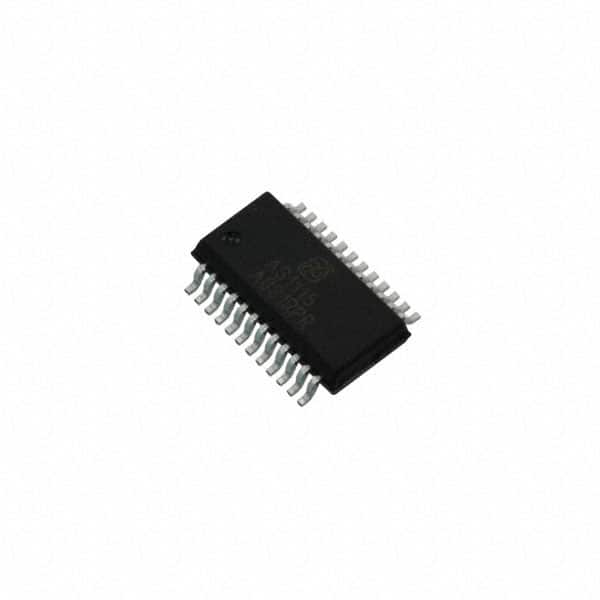Viz Specifikace pro podrobnosti o produktu.

AS1115-BSST
Product Overview
Category
AS1115-BSST belongs to the category of integrated circuits (ICs).
Use
The AS1115-BSST is commonly used for driving LED displays in various applications.
Characteristics
- The IC is designed to control up to 8 digits, each with 7 segments.
- It supports multiplexing and scanning of LED displays.
- AS1115-BSST offers a wide range of features for display control, such as brightness adjustment and segment blinking.
- It operates on low power consumption, making it suitable for battery-powered devices.
Package
AS1115-BSST is available in a compact surface-mount package.
Essence
The essence of AS1115-BSST lies in its ability to efficiently drive LED displays while providing flexibility in controlling various display parameters.
Packaging/Quantity
AS1115-BSST is typically packaged in reels or tubes, with quantities varying based on customer requirements.
Specifications
- Supply Voltage: 2.7V to 5.5V
- Maximum Display Digits: 8
- Maximum Segment Current: 25mA
- Communication Interface: I2C/SPI
- Operating Temperature Range: -40°C to +85°C
Detailed Pin Configuration
- VDD - Power supply voltage
- GND - Ground
- SDA - Serial data input/output (I2C)
- SCL - Serial clock input (I2C)
- CS - Chip select (SPI)
- DIN - Serial data input (SPI)
- CLK - Serial clock input (SPI)
- DOUT - Serial data output (SPI)
- INT - Interrupt output
- RST - Reset input
Functional Features
- Multiplexing and scanning of up to 8 digits
- Individual control of segment brightness
- Segment blinking and dimming capabilities
- Built-in key scanning functionality
- Programmable display patterns
- Error detection and reporting
Advantages and Disadvantages
Advantages
- Versatile display control options
- Low power consumption
- Compact package size
- Wide operating voltage range
- Integrated key scanning functionality
Disadvantages
- Limited maximum segment current
- Requires additional external components for LED driving
Working Principles
AS1115-BSST utilizes a combination of multiplexing and scanning techniques to drive LED displays efficiently. It communicates with a microcontroller through the I2C or SPI interface, enabling flexible control over various display parameters. The IC generates the necessary signals to activate specific segments of the LED display, achieving the desired visual output.
Detailed Application Field Plans
AS1115-BSST finds applications in various fields, including: 1. Consumer electronics: digital clocks, home appliances, remote controls. 2. Automotive: dashboard displays, infotainment systems. 3. Industrial equipment: measurement instruments, control panels. 4. Medical devices: patient monitoring systems, diagnostic equipment. 5. Gaming: slot machines, arcade games.
Detailed and Complete Alternative Models
- AS1117-BTST: Similar to AS1115-BSST but supports 16 digits instead of 8.
- MAX7219: Another popular LED display driver IC with similar features.
- HT16K33: Offers compatibility with both I2C and SPI interfaces.
These alternative models provide similar functionality to AS1115-BSST and can be considered based on specific project requirements.
Word count: 511 words
Seznam 10 běžných otázek a odpovědí souvisejících s aplikací AS1115-BSST v technických řešeních
Sure! Here are 10 common questions and answers related to the application of AS1115-BSST in technical solutions:
Q: What is AS1115-BSST? A: AS1115-BSST is a specific model of LED driver IC (integrated circuit) designed for driving multiple segment displays or dot matrix displays.
Q: What are the key features of AS1115-BSST? A: The key features of AS1115-BSST include high integration, low power consumption, support for multiplexing, and compatibility with various display types.
Q: How does AS1115-BSST communicate with microcontrollers or other devices? A: AS1115-BSST typically uses I2C (Inter-Integrated Circuit) communication protocol to interface with microcontrollers or other devices.
Q: Can AS1115-BSST drive both common anode and common cathode displays? A: Yes, AS1115-BSST can drive both common anode and common cathode displays, making it versatile for different display configurations.
Q: What is the maximum number of displays that AS1115-BSST can drive? A: AS1115-BSST can drive up to 8 seven-segment displays or 64 individual LEDs, depending on the configuration.
Q: Does AS1115-BSST have built-in brightness control? A: Yes, AS1115-BSST has built-in PWM (Pulse Width Modulation) control for adjusting the brightness of the connected displays.
Q: Can AS1115-BSST handle multiplexing of displays? A: Yes, AS1115-BSST supports multiplexing, allowing efficient control of multiple displays using fewer pins on the microcontroller.
Q: Is AS1115-BSST suitable for battery-powered applications? A: Yes, AS1115-BSST is designed to be power-efficient, making it suitable for battery-powered applications where low power consumption is crucial.
Q: Are there any application examples for AS1115-BSST? A: AS1115-BSST can be used in various applications such as digital clocks, panel meters, industrial control systems, and consumer electronics.
Q: Where can I find more information about AS1115-BSST and its application notes? A: You can refer to the datasheet and application notes provided by the manufacturer of AS1115-BSST for detailed information on its usage and application guidelines.
Please note that the specific details and answers may vary depending on the manufacturer's documentation and specifications of AS1115-BSST.

